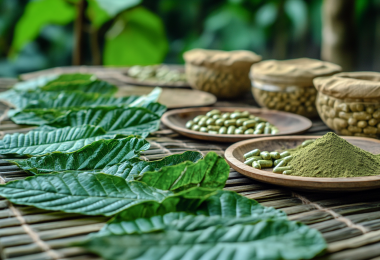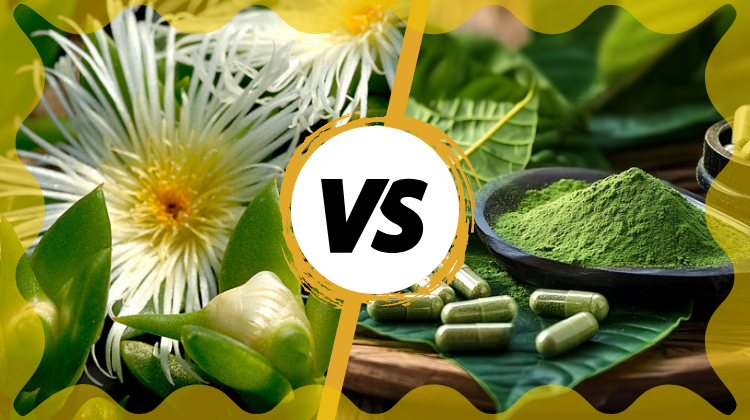
What is Kratom? The Complete Guide from Golden Monk
Introduction Kratom is a plant that inspires curiosity, debate, and misunderstanding. Some people hear about...
View PostYour cart is currently empty.
Continue ShoppingMenu
Cart
Your cart is currently empty.
Continue ShoppingSearch

Kanna vs Kratom is a comparison many botanical enthusiasts explore when deciding between these two unique plants. While Kanna and Kratom share some similarities, they differ greatly in origin, alkaloid content, and traditional uses. From Kanna tea to Kanna extract, and from red to white Kratom strains, each offers its own profile and cultural story. When you compare Kratom and Kanna, you’re looking at two botanicals with distinct origins, chemical profiles, and cultural legacies.
If you’ve ever asked yourself What is Kanna? Kanna (Sceletium tortuosum) is a South African botanical known for its long-standing role in traditional practices. Today, it’s often made into Kanna tea or concentrated as Kanna extract. Kanna effects are linked to alkaloids like mesembrine and mesembrenone, which interact with serotonin pathways for a steady, grounded experience.
Kratom (Mitragyna speciosa), native to Southeast Asia, has been part of cultural traditions since the 19th century. Its leaves contain over 50 alkaloids, with mitragynine and 7-OH standing out. These engage various receptors, shaping the character of different strains.
This guide takes a balanced look at Kanna vs Kratom, exploring their origins, chemistry, and qualities, to help you compare Kratom and Kanna and see which suits your preferences.
Kanna and Kratom are both plants, but their stories start on different continents with very different roots.
Kanna: Kanna (Sceletium tortuosum) grows in South Africa. The Khoisan people have valued it for hundreds of years. It contains natural alkaloids like mesembrine and mesembrenone. These work with serotonin systems and PDE4 enzymes. Studies link these compounds to steady focus, mental flexibility, and better stress handling.
Kratom: Kratom (Mitragyna speciosa) grows in tropical Southeast Asia, mainly Thailand, Indonesia, and Malaysia. Western scientists first wrote about it in the mid-1800s. Locals have valued its leaves for many years. The plant holds more than 50 alkaloids. The main ones are mitragynine and 7-hydroxymitragynine (7-OH). These affect many receptor systems. White strains are often seen as energizing [1] and stimulating [2], red strains as soothing [3], and green strains as energy-focused [4].
Where each plant grows, and how it is prepared, still shapes the way people see them today.
Kanna | Kratom |
Leaves and stems are harvested. | Leaves are harvested. |
Contains mesembrine, mesembrenone, and mesembrenol. | Contains mitragynine, 7-hydroxymitragynine, and over 50 other alkaloids. |
Traditionally dried, chewed, brewed as tea, or fermented. | Traditionally chewed fresh, brewed as tea, or powdered, Kratom is now also available in shots and capsules for added convenience and variety. |
No strains. | White, red, green |
Available as powders, teas, extracts, and capsules | Available as loose leaf, powders, capsules, and blends |
Hand-harvested, sun-dried, or fermented | Hand-picked, dried, and sometimes fermented by strain type |
Kanna and Kratom differ in where they grow, their natural composition, and their traditional applications. Knowing these differences can help you decide which might suit your preferences.
Are you searching for Kratom alternatives, read our blog on alternatives to Kratom to gain a better understanding.
Kanna: Its compounds interact with serotonin transporters and inhibit the PDE4 enzymes.
Kratom: Its alkaloids work with multiple receptor systems, including opioid and dopamine receptors. Strain variations matter: white strains can be energizing [5] and stimulating [6], red strains are more calming [5], and green strains are often linked to energy [6].
Kanna: May support a lighter mood, promote relaxation without drowsiness, encourage social comfort, and aid in adapting to stress.
Kratom: Different strains are linked to various effects. Some are described as energizing and stimulating [7], while others are more calming [8] or energy-focused [9].
Kanna: Generally legal in most countries, though status can change if regulations shift.
Kratom: In the U.S., regulation is at the state level, and some states have adopted Kratom Consumer Protection Acts (KCPA).
When you’re deciding between Kanna and Kratom, start with what matters most to you. Is it tradition, variety, or availability? Both plants have their strengths, and understanding them can make your choice easier.
Look for brands that share details about where and how their plants are grown. Region and climate can influence the plant’s natural profile. Kanna from South Africa and Kratom from Southeast Asia each have distinctive qualities shaped by their native environments.
Freshness matters. Products that are carefully dried and stored keep their natural character longer. Many reputable sellers also provide independent lab reports, which confirm plant identity and purity.
Think about form and variety. Kanna is often offered as dried plant material, powders, teas, and extracts. Kratom is widely available as loose leaf, powder, and capsules. If you enjoy exploring different experiences, Kratom’s strain options: white, red, and green, each have their profiles.
Finally, read reviews from other buyers. Their experiences can give you a better idea of what to expect while helping you find a trusted supplier.
In the Kanna vs Kratom debate, both offer distinct traditions, alkaloid profiles, and preparation styles. Whether you prefer the simple forms of Kanna tea and extracts or the variety of Kratom strains, knowing their origins and qualities will guide your choice.
Kanna and Kratom each carry unique traditions, natural compounds, and experiences. While Kanna’s history is rooted in South Africa’s cultural practices, Kratom’s story unfolds across Southeast Asia’s tropical landscapes. The right choice depends on your preferences, lifestyle, and what you value in a botanical. Some may be drawn to Kanna’s straightforward forms, while others explore Kratom’s variety of strains and profiles.
Whatever you choose, focusing on freshness, careful processing, and transparent lab testing ensures you’re selecting a product that reflects its origin and quality. With the correct information, you can explore these plants with curiosity and confidence.

Introduction Kratom is a plant that inspires curiosity, debate, and misunderstanding. Some people hear about...
View Post
Ever wondered what’s really in your Kratom? Lab test reports are the key to understanding...
View Post
Are you also confused about which Kratom form you should try for your busy schedule?...
View PostBy clicking yes you also confirm that you have read and agree to GoldenMonk's Terms of Service and Privacy Policy and Goldenmonks’s service provider’s terms of service and privacy policy.